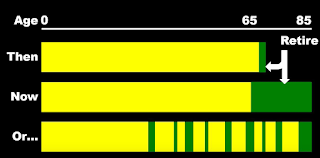FIRE is a term that has been thrown around very frequently. FIRE stands for financially independent, retire early which seems like the ultimate dream/goal for many. Yes, I think everyone should know about this concept and think about reaching FI (being financially free). We all live with lots of worries everyday, money definitely weighs heavily on most people.
Being financially independent can open up doors for us providing us with many options and we can do things that we want without thinking about our next meal or whether can we afford the lifestyle we are currently having. For now, I work because I need the job that I currently have to pay the bills, daily necessities and to provide for my family as well. What if I can work with no more worries for those? I think I would be less stress if I knew that I didn't need the job to cover my daily necessities. I want to be financially free to do the things I like and spend time with people I love. But I might not retire early because I find work rather fulfilling, having colleagues and also feeling of accomplishment when you complete your daily tasks. But being financially independent is a goal that I am aiming for.
I watched this TedTalk by Lacey Filipich where she described how she was time-poor when she started work, thinking that things will not go on in her work if she ever took a day off and so she didn't ever took a day off. The turning point came for her when she became really ill and was bedridden for 5 weeks. It made her realised that her career was nothing much and it was the one causing her health to deteriorate. She took a break and got back to work falling into her old routine, then her sister commited suicide and made her start thinking again.
So most people work hard for 40 years then reach retirement where they move from being time-poor to time-rich but by then they would have become too old to enjoy the experiences that they might have wanted when they were younger due to concerns of health or energy. So instead, we could take mini-retirements throughout our lifetime and to do this, we can have a small business on the side which can fund it while we take these min-retirements.
Definitely, in a Singapore context, it is not easy because for most of us, our main job is really our main source of income and with mortgages and other bills, we might not be able to afford to take so many mini-retirements.
Taken from Why you should think about financial independence and mini-retirements | Lacey Filipich | TEDxUWA
So to be able to afford these mini-retirements, start investing and saving. So you can move from being time-poor to time-rich. InvestmentMoats is a great personal finance and investing website where I read him articles for information, he has an article which writes about the 11 stages of financial independence. He mentioned that the higher you go into the stages, the more useful wealth is for you.
I wouldn't go into the details as I believe that you can go over to his website where he has a very extensive explanation on it all. Link is below. Definitely, not everyone will reach level 10 and everyone will progress differently. This serves as a guide to see where you are at and which stage are you aiming for.
The 11 Stages of Wealth: Which Stage of Wealth are You at? | Investment Moats
What is really important is the mindset that you have, knowing that you have a goal for the money that you are saving and investing for will make you treasure them and not waste them away on unnecessary expenses. With 2020 being a crazy year filled with retrenchments and uncertainty, many have now realised the importance of saving for a rainy day, besides that, 2020 has made me realise how fragile life can be and I really want to enjoy my time without working till old age.
Having this mindset keeps me aware of my expenses and how much I am keeping aside, this provides me with a overall view of how long more I need to be financially free. For example, your hourly rate is $20/hour and this means a meal on a Sunday with your family amounts to 5 hours of your working hours, this does make your heart kinda ache as 5 hours of your hard work is gone in one meal. To be able to know of the FIRE concept and be able to pursue it means that you are privileged and I believe once you are aware that you are exchanging your time for money, you will want to move from being time-poor to time-rich.
Hope you guys enjoy my video content, do like, share and subscribe to my channel for more content!






